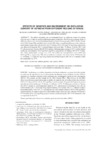Please use this identifier to cite or link to this item:
http://www.alice.cnptia.embrapa.br/alice/handle/doc/463630| Title: | Effects of genetics and environment on isoflavone content of soybean from different regions of Brazil. |
| Authors: | CARRÃO-PANIZZI, M. C.  BELÉIA, A. D. P.   KITAMURA, K.   OLIVEIRA, M. C. N.   |
| Date Issued: | 1999 |
| Citation: | Pesquisa Agropecuária Brasileira, Brasília, v. 34, n. 10, p. 1787-1795, out. 1999. |
| Description: | The effects of genetics and environmental factors on isoflavone content of soybean (Glycine max L.) cultivars grown in different locations in Brazil in 1993/94 were evaluated. Seeds of different cultivars were analyzed by high performance liquid chromatography (HPLC). In Rio Grande do Sul (RS), Paraná (PR), and Mato Grosso do Sul (MS) States, a significant difference in the isoflavone total content average of the cultivars IAS 5 and FT-Abyara (163.9, 116.4 and 79.5 mg/100 g, respectively) was observed. In general, IAS 5 contained higher isoflavone than FT-Abyara. Cultivars IAS 5 and FT-Abyara grown at Vacaria, RS (28°30' S latitude) with temperature average of 19°C, had the highest isoflavone concentrations (218.7 and 163.8 mg/100 g, respectively). In Palotina, PR (24°27' S latitude), where temperature average was 24°C, the isoflavone concentrations were 105.9 and 86.8 mg/100 g, respectively. The lowest isoflavone contents were observed for FT-Estrela and FT-Cristalina, (27.6 and 46.5 mg/100 g, repectively) at Rondonópolis, MT (16°20' S latitude), where the temperature was 27°C. |
| Thesagro: | Soja |
| Type of Material: | Artigo de periódico |
| Access: | openAccess |
| Appears in Collections: | Artigo em periódico indexado (CNPSO)  |
Files in This Item:
| File | Description | Size | Format | |
|---|---|---|---|---|
| pab97351ing.pdf | 41.79 kB | Adobe PDF |  View/Open |









